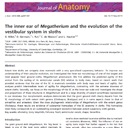















| Plane | Position | Flip |
| Show planes | Show edges |
0.0
M3#14
This model corresponds to a virtually reconstructed bony labyrinth of the right inner ear of the skull MNHN-F-PAM 276, attributed to the extinct giant ground sloth Megatherium americanum. The fossil comes from Pleistocene deposits at Rio Salado (Prov. Buenos Aires, Argentina). The bony labyrinth of Megatherium shows semicircular canals that are proportionally much larger than in the modern two-toed and three-toed sloths. The cochlea in Megatherium shows 2.5 turns, which is a rather high value within Xenarthra. Overall, the shape of the bony labyrinth of Megatherium resembles more that of extant armadillos than that of its extant sloth relatives.
Data citation:
Guillaume Billet , Damien Germain
, Irina Ruf
, Christian de Muizon
and Lionel Hautier
, 2015. M3#14. doi: 10.18563/m3.sf14
Model solid/transparent

|
3D model related to the publication: The inner ear of Megatherium and the evolution of the vestibular system in sloths.Guillaume Billet, Damien Germain, Irina Ruf, Christian de Muizon and Lionel HautierPublished online: 24/02/2015Keywords: bony labyrinth; inner ear; Megatherium; Sloth https://doi.org/10.18563/m3.1.2.e3 Abstract This contribution contains the 3D model described and figured in the following publication: Billet G., Germain D., Ruf I., Muizon C. de, Hautier L. 2013. The inner ear of Megatherium and the evolution of the vestibular system in sloths. Journal of Anatomy 123:557-567, DOI: 10.1111/joa.12114. See original publication M3 article infos Published in Vol. 01, Issue 02 (2015) |
|